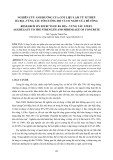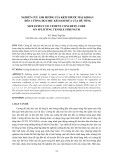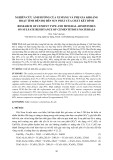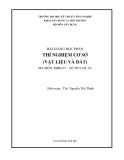
Journal of Science and Transport Technology Vol. 2 No. 1, 9-20
Journal of Science and Transport Technology
Journal homepage: https://jstt.vn/index.php/en
JSTT 2022, 2 (1), 9-20
Published online 12/02/2022
Article info
Type of article:
Original research paper
DOI:
https://doi.org/10.58845/jstt.utt.2
022.en.2.1.9-20
*Corresponding author:
E-mail address:
sonth@utt.edu.vn
Received: 05/12/2021
Revised: 22/01/2022
Accepted: 08/02/2022
Prediction of compressive strength of
concrete at high heating conditions by using
artificial neural network-based Bayesian
regularization
Marijana Hadzima-Nyarko1, Son Hoang Trinh2*
1Josip Juraj Strossmayer University of Osijek, Faculty of Civil Engineering and
Architecture Osijek, Vladimira Preloga 3, 31000 Osijek, Croatia
2University of Transport Technology, Hanoi 100000, Vietnam
Abstract: Cement concrete is the most commonly used material today for
constructing residential or commercial buildings, industrial parks, or particular
components such as tunnel slabs where there is a high risk of fire. This
structure requires concrete to be subjected to high temperatures generated by
fires. However, concrete under the influence of high temperature has very
complex behavior states with deformations, physical and chemical changes as
the temperature rises dramatically. In this study, an artificial neural network-
based Bayesian regularization (ANN) model is proposed to predict the
compressive strength of concrete. The database in this study includes 208
experimental results synthesized from laboratory experiments with 9 input
variables related to temperature change and design material composition. The
performance of the ANN model was evaluated using K-fold cross-validation
and statistical criteria, including mean absolute error (MAE), root mean square
error (RMSE), and coefficient of determination (R2). The results show that the
proposed ANN model is a reasonable, highly accurate, and useful prediction
tool for saving time and minimizing costly experiments.
Keywords: Machine learning, ANN, compressive strength, Bayesian
regularization, K-fold cross-validation.
1. Introduction
Due to its non - flammable properties and low
thermal gradient, concrete is known to perform well
at high temperatures, ensuring that thermal
transients propagate slowly inside structural
elements. Nonetheless, high-temperature
microstructural transformations in concrete involve
complicated physicochemical processes in the
component. On concrete, high temperatures cause
two primary concerns. One is the damage of
concrete's mechanical properties, which includes
physicochemical variations in the binder and
aggregate, thermal differences between the
aggregate and the cement matrix as a temperature
level and rate, applied force, and outer coating,
which reduces evaporation from the concrete's
surface. At higher temperatures, an exact number
of physicochemical changes appear in the
material: physically-compounded H2O is delivered
over 100°C; dioxolane hydrate dissociates over
300°C; calcium hydroxide hydrolyzed over 500°C;
and several aggregates begin transferring or
disintegrate at various temperatures (delivery of
adsorbed H2O, quartz SiO2-conversion, limestone

JSTT 2022, 2 (1), 9-20
Hadzima-Nyarko & Trinh
10
decomposing). Simultaneously, the second issue is
concrete spalling. Ordinary concrete spalls due to
fast temperature rises (about 20oC/min) [1]. In the
transition zone between these two stages, the
contrasting strains of the aggregate (expansion)
and the cement matrix (drying shrinkage) initiate a
distributed series of micro-cracks [2]. In addition,
Spalling is caused by thermal strain and vapor
pressure build-up in some situations, exposing
deeper layers of concrete to burning and speeding
up the heat transfer rate [3].
According to prior published studies [4, 5],
the factors associated with the type of concrete
have a significant correlation, and the type of
material components impact the concrete
compressive strength at high thermal conditions.
Husem [6] researched how flexural and
compressive resistance varied as high-
performance concrete (HPC) and conventional
Portland concrete (PC) were subjected to the heat
of 200, 400, 600, 800, and 1000°C and
subsequently cooled in water or air. The results
show that (a) the compressive resistance of PC
and HPC subjected to high thermal reading reduce
as the temperature rises. The quick expansions
that occur in the process of the deformation of
mineral additive used in the HPC at high
temperatures may cause the concrete to drop its
strength. The results of the experiments showed
that regular and high-performance concretes made
with limestone aggregate lost a substantial amount
of strength deprivation when chilled in freshwater
since being subjected to extreme heat. Chan et al.
[7] investigated the compressive and thermal
behaviors of HPC at heating from 800 to 1100oC,
and through the cooling process. It is discovered
that followed by a gradual (26-34%) and quick (22-
28%) cooling procedure, the strength attributes
dropped dramatically. Tanyildizi et al [8] evaluated
the influence of high temperatures on
featherweight concrete's tensile and compressive
resistance using fly-ash. Temperatures of 200, 400,
and 800oC were carried out in his study. Concrete's
compressive and splitting tensile strength were
reduced by 63.8% and 76.45%, respectively, at
800oC. Chan et al. [9] studied traditional and high-
strength concrete put in high thermal conditions.
The concrete compressive resistance at 28-day
ages was measured after various temperature
treatment durations (400,600, 800, 1000, and
1200oC). According to Tang et al., the concrete
compressive strength using rubber-modified-
recycled based aggregate was evaluated as rising
heat [10].
It is evident that the compressive strength of
concrete is affected by temperature variations,
input material type, and mix proportions [1, 2, 11].
Typically, the statistical regression method
estimates the concrete compressive strength at
high thermal conditions based on laboratory test
data. Although regression analysis appears to be
easy and straightforward, the difficulty in the
analysis increases as the number of independent
variables grows [12]. More advanced techniques,
such as Machine learning (ML), are used in
complicated scenarios to improve model prediction
accuracy. When considering the temperature
changes, ML algorithms perform better and have a
lower variance [11]. Some studies on predicting
compressive strength of concrete based on ML
models [13–22]. It can be seen that ANN is a
commonly used model in research on strength
prediction of concrete because its effectiveness in
nonlinear modeling has been well demonstrated,
and its mathematical background is clear [23].
Hocine et al [24] predicted the compressive
strength of concrete using limestone powder by
applying the ANN model based on 7 input variables
related to the proportions and age. The results
show that the correlation coefficient (R2) of all
training, testing, and validation phases is very high
(over 97%). In addition, Behfernia et al [25]. used
ANN and adaptive neural-based fuzzy inference
(ANFIS) to predict the compressive strength of
conventional concrete (without using admixtures or
additives such as fly ash, silica fume, blast furnace
slag, etc.) based on 160 samples and 7 input
parameters related to proportions. The results
show that although both ANFIS and ANN show
strong predictive power, ANN has better

JSTT 2022, 2 (1), 9-20
Hadzima-Nyarko & Trinh
11
performance. Several studies [13–16] show that
ANN is a very effective model for predicting the
compressive strength of self-compacting concrete.
Like other ML methods, ANN can suffer from an
overfitting problem (especially with too small data
but too high model complexity) [26]. The
regularization in the ANN allows reducing error for
obtaining the highest coefficient of correlation and
lowest total square errors [27]. A tuning
regularization technique in ANN that has been
used very effectively is Bayesian regularization
which has been used to successfully study various
problems such as stock price prediction, data
mining, etc [28–32]. Pre-distribution of model
parameters and management of large weights are
some of the Bayesian regularization strategies
used for ANNs to obtain smoother mapping [33].
Currently, there is no evaluation of the ANN-
based Bayesian regularization model's
effectiveness in predicting the strength of concrete
as subjected to high temperatures. So, the
development of this ML model to predict
compressive strength and performance
comparison was evaluated as part of this study's
novelty. Temperature and material composition,
including water, cement, coarse aggregate, fine
aggregate, nano-silica, fly ash, super-plasticizer,
and silica fume, were the 9 input parameters
considered and used to evaluate the efficacy of the
developed ANN technique in predicting concrete
compressive strength.
2. Database construction
This paper develops an ANN model based on
Bayesian regularization based on 208
experimental data to forecast concrete's
compressive strength. The factors affecting the
compressive strength of concrete such as the
content of ingredient material in the designed
concrete mixture, including water, cement,
aggregate (coarse sand/fine), mineral additives
(silica-fume, nano-silica, fly ash), chemical
additives (super-plasticizers), and subjected
temperature have all been demonstrated in
previous studies [34–39]. The statistical
information of the input and output parameters is
shown in Table 1. The input variables are denoted
by I1 to I9, and the output parameter is denoted by
O.
Table 1. Statistical analysis of the input parameters in this study
Calculate for 1m3 concrete
Parameters
Abbreviation
Unit*
Min
Max
Mean
StD
Inputs
Cement
I1
kg
250
786
437.69
95.49
Water
I2
kg
123
385
182.75
59.95
Fine Aggregate
I3
kg
0
1345
610.13
317.39
Coarse Aggregate
I4
kg
0
1681
1052.13
309.41
Fly Ash
I5
kg
0
150
12.65
33.07
Super Plasticizer
I6
kg
0
25.9
8.58
7.60
Silica Fume
I7
kg
0
150
29.32
37.09
Nano Silica
I8
kg
0
22.5
1.74
5.25
Temperature
I9
(oC)
20
1000
354.52
287.65
Output
Compressive strength
O
(MPa)
3
133.6
49.31
25.17
Fig 1 shows correlation matrix analysis,
which visualizes the relationship between variables
and analyzes each variable's effect on the
problem's output variable. Different colors describe
the correlation values. The blue square represents
the negative correlation, and the red color
represents the positive correlation. The pairs of
attributes with a high degree of correlation can be
removed to reduce the influence of unnecessary
variables on the predictive model. The correlations
between the inputs and output are not strictly
linear, with a maximum correlation value of about

JSTT 2022, 2 (1), 9-20
Hadzima-Nyarko & Trinh
12
0.5. So, all inputs are considered as independent
variables, while output as a dependent variable is
predicted based on these independent ones.
The dataset is divided into two groups for
training and testing phases with a ratio of 70:30 to
build the model. Finally, statistical parameters and
K-fold cross-validation validate the generated
model.
Fig 1. The distribution chart and correlation
between inputs and output in this work
3. Model Details
3.1. ANN
Artificial Neural Networks (ANN) have been
introduced since the 1940s [23]. ANN is a strong
machine learning-based data analysis technique
that is based on actual biological neural networks
and is used to analyze large amounts of data. This
ML technique aims to imitate the knowledge
acquisition and inference processes in the human
brain to improve performance [40]. The use of
artificial neural networks (ANNs) to handle
nonlinear regression analysis issues has become
more and more popular.
The ANN is set up to work based on
biological neurons. A set of neurons is arranged so
that all neurons receive an input signal and output
signal simultaneously, and such a set is called a
network layer [41]. The most straightforward neural
network consists of a layer specializing in receiving
input signals and input variables (input layer), and
the output layer releasing the output signals.
Hidden layers are those that exist between the
input and output layers. These hidden layers
contain hidden neurons, i.e., the intermediate
results of the neural network's output value
computation process. A neural network can have
many hidden layers. If there are too many hidden
layers, the model will fit the data well, which also
means that the model will be more accurate in
estimating the weights but will be less accurate in
predicting out-of-sample measurements [42]. In
addition, the larger the number of hidden layers,
the greater the number of weights in the model
thereby making the model estimation time longer
[43]. The structure of an ANN model in this study is
shown on Fig. 2.
Fig 2. The structure of ANN in this study
The use of Bayesian regularization in artificial
neural network training/learning is much more
potent than the standard back-propagation
algorithm since it decreases or removes the
requirement of extensive cross-validation [44]. In
the same way, the regression method makes a non
- linear model into a "well-posture" statistic issue,
Bayesian regularization does the same for a
nonlinear regression [33]. As a result, the models
are reliable, and the assessment procedure is the
advantage of Bayesian regularized-based artificial
neural networks.

JSTT 2022, 2 (1), 9-20
Hadzima-Nyarko & Trinh
13
In statistics, the Bayesian approach differs
from the probability perspective in hypothesis
validating. It is founded on a couple of basic
concepts: (1) probability is a metric of confidence
of the events occurring, (2) past assumptions affect
subsequent assumptions. The Bayes theorem
states that [45]:
H
P(D \ H)P(H) P(D,H)
P(H \ D) P(D) P(D,H')dH'
==
(1)
H
P(D) P(D,H')dH'=
(2)
The equation also holds in the probability
approach, in which H and D are regarded groups
of outcome measures. H is a hypothesis regarding
if it has some previous assumption, and D is
information that will modify one's assumption about
H, according to the Bayesian approach. The
probability is defined as P(D|H). It represents the
model's unpredictability (aleatoric–uncertainty),
i.e., the controversial question or uncertainty by
process noise in the model. The prior is P(H) and
Eq (2) is subsequent. The posterior is defined as
P(H|D).
To put it another way, the Bayesian theory
provides a good framework for quantifying
uncertainties in ML techniques. Also, it gives an
accurate basis for interpreting several of the
regularization methods and training tactics utilized
in traditional ML [46].
3.2. K-Fold cross-validation
When it comes to estimating the performance
of machine learning models, cross-validation is the
statistical approach utilized. It is often used to
compare and select the most appropriate model for
a given situation. Compared to previous
approaches, this strategy is simple to grasp and
use, providing more reliable estimations [47]. The
most critical parameter to consider when using this
strategy is K, which specifies the number of groups
into which the data will be divided. It is referred to
as K-fold cross-validation as a result of this. When
a value of K is chosen, that value is used directly in
the name of the evaluation method. This technique
usually includes the following steps [48]:
- Shuffle the dataset at random
- Divide dataset into K groups. For each
group: (i) Use the current group to evaluate model
effectiveness; (ii) The remaining groups are used
to train the model; (iii) Train the model; (iv) Evaluate
and then reject the model
- Synthesize the effectiveness of the model
based on the evaluation data
The total results are usually the average of
the evaluations. In addition, the addition of
variance and standard deviation information to the
total results is also used in practice [49]. On the
other hand, if K is chosen too large, the training set
will be much larger than the testing set, and the
evaluation results will not reflect the true nature of
the machine learning method, especially with large
data sets. That is also the reason why the 10-fold
cross-validation is chosen by many researchers
[11,48]. Therefore, in this study, K=10 was selected
(10-fold cross-validation).
3.3. Performance assessment
The proposed ANN model's performance is
evaluated using several indicators, comprising
mean absolute error (MAE), root mean square
error (RMSE), mean squared error (MSE), mean
absolute percentage error (MAPE), and coefficient
of determination (R2).
The following equations reflect these values
[43]:
( )
( )
2
n
i 1 i i
2
2
n
i 1 i
PE
R1
P
=
=
−
=−
(3)
( )
n2
ii
i1
1
RMSE P E
n=
= −
(4)
n
ii
i1
1
MAE P E
n=
= −
(5)
n
ii
t1 i
EP
100%
MAPE nE
=
−
=
(6)
Where E is the actual experimental value, P
denotes the expected value based on the model's
estimate, and n denotes the total sample sizes in
the dataset.
R2 is an important criterion in regression
analysis. It is understood as the square of the












![Bài giảng Quản lý vận hành và bảo trì công trình xây dựng [chuẩn nhất]](https://cdn.tailieu.vn/images/document/thumbnail/2025/20251006/agonars97/135x160/30881759736164.jpg)









![Ngân hàng câu hỏi trắc nghiệm Sức bền vật liệu 1: [Mô tả/Định tính Thêm để Tăng CTR]](https://cdn.tailieu.vn/images/document/thumbnail/2025/20250920/kimphuong1001/135x160/6851758357416.jpg)


![Trắc nghiệm Kinh tế xây dựng [chuẩn nhất]](https://cdn.tailieu.vn/images/document/thumbnail/2025/20250920/kimphuong1001/135x160/32781758338877.jpg)
